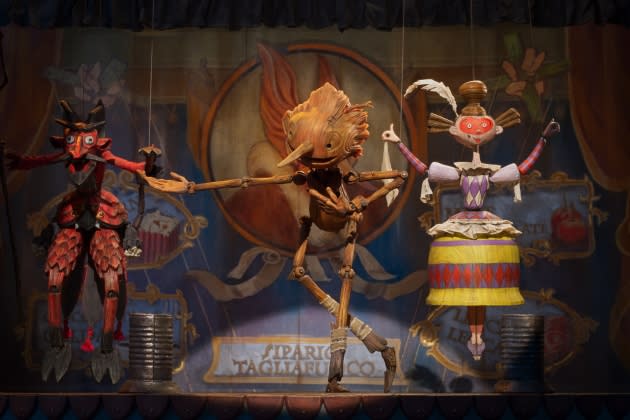How ShadowMachine Worked With Guillermo del Toro to Bring ‘Pinocchio’ to Life
- Oops!Something went wrong.Please try again later.
- Oops!Something went wrong.Please try again later.

For Alex Bulkley and Corey Campodonico, co-founders of ShadowMachine, a boutique animation studio and production house, work on “Guillermo del Toro’s Pinocchio” began a decade ago as some of the first concept art was being created.
“We were first introduced to Guillermo del Toro through Lisa Henson back in 2012,” says Bulkley. “At that point, obviously, we were years away from actually making it, but it allowed for us to start building relationships with [animation house] Mackinnon & Saunders in the U.K. and [co-helmer] Mark Gustafson. By the time we actually were greenlit through Netflix, we had a good idea of what Guillermo wanted to do, which is innovate stop motion by way of a grounded world. What’s amazing about working with Guillermo, as well as Mark, is they have such a clear point of view on what the storytelling is. It allowed the artists that we assembled for this film to really do their best work in executing that vision.”
More from Variety
Inside How Stop-Motion Animated Movies Had a Huge Year in 2022
Guillermo del Toro Explains Why 'Pinocchio' Is Not a Kids Movie But Still Enjoyable For Families
For this film, Bulkley, Campodonico and their team of about 375 artists used both mechanical stop motion and replacement techniques. In mechanical stop motion, the artists physically move the face of the puppets and carefully photograph them to show the emotions they want to see. In replacement stop motion, hundreds of face masks can be manufactured using a 3D printer and placed on the puppets to show changes in feeling. In “Pinocchio,” Geppetto’s performance was created with mechanical stop motion but Pinocchio is made of wood, so replacement stop- motion techniques were perfect for crafting his performance.
Some characters can utilize both types of stop motion. Spazzatura, the monkey who assists the villain Count Volpe, had eyebrows and eyes that were mechanical so they were moved by hand by the artists but the muzzle and mouth area were replacement stop motion. The muzzle area created a kind of natural border where they could separate the different areas of the face without disturbing the performance. The two techniques were used together to create the exaggerated and wildly emotional expressions of the character.
The ShadowMachine team used pizza boxes with partitions to hold replacement faces and muzzles to deliver them to the various crews working on the film. At the height of production, they had about 60 units shooting at once, each one needing its own replacement kit.
“You have to be simultaneously shooting on many stages at the same time with the same cast of characters,” says Campodonico. “So, the workload on the puppet departments and the set departments and the lighting department and the camera department is so demanding because of the multiple matching that you’re doing constantly.”
Though this is del Toro’s first theatrically released stop-motion film, the filmmaker had worked on a previous stop-motion project in Guadalajara but abandoned it after a tragedy. He and his team had completed around 100 puppets for the story when someone broke into his studio and destroyed their work and vandalized the studio. Shaken by what happened, del Toro took it as a sign that he should work in live action.
“Given how long it took to finish this project, and the sort of collective blood, sweat and tears in the community that was formed around it, the movie is really the result of what was an amazing collaboration,” says Bulkley. “It was close to 1,000 days of actually making this, bringing to this vision to life. We’re very proud to have been part of it.”
Best of Variety
Sign up for Variety’s Newsletter. For the latest news, follow us on Facebook, Twitter, and Instagram.
